|

|
Faster Than Light
Transmission of Signals
|
|
Prof. Dr. Guenter Nimtz
|
Original article
by E. Habich
|
Background:
Superluminal tunneling (faster than light transmission
of signals) was first observed at the University of Cologne
with microwave photons. Soon thereafter these experiments
were duplicated and validated at the University of Berkeley
and Vienna. For theoretical physics the implication is that
there exist spaces, devoid of time.
9th September 1999: Having met Prof. Dr. Nimtz for the first time
I was shown his new tunneling experiment. As a lay person
I'm not able to launch immediately into an in-depth scientific
interpretation of his experiment but I will dutifully try
to comprehend what I saw today, and try and share my insights
and questions and make the data available as they become
known.
I present here for the first time world-exclusive
pictures of Prof. Nimtz's new experiment setup. For
further background information: click
here
Prof.
Dr. Nimtz present experiment takes it's inspiration from an
experiment by Jagadis
Chandra Bose, an Indian physicist born in 1858. Bose's
successful public demonstration of remote signaling with radio
waves in 1895 predate Marconi's experiments by two years.
In 1897 Bose carried out experiments with semiconductors at
frequencies as high as 60 GHz and was in the opinion of Sir
Neville Mott, Nobel Laureate in 1977, at least 60 years ahead
of his time.
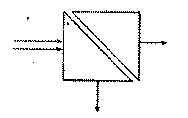
Bose's 1897 diagram of a double-prism
Modern
measuring devices make it possible to investigate the effects
of total reflection in more detail and to compare the results
with what is known these days about quantum tunneling.
 The
new experiment of Prof. Nimtz explores total internal reflection
of micro waves inside a dielectric prism, and the effect and
characteristics of a small air gap between two identical prisms.
One known effect of quantum tunneling is the propagation
of photons at speeds much faster than light. The exact measure
of this effect is as yet unknown in this setup. Previous tunneling
experiments in different constellations have shown superluminal
effects of up to 30x the speed of light. The
new experiment of Prof. Nimtz explores total internal reflection
of micro waves inside a dielectric prism, and the effect and
characteristics of a small air gap between two identical prisms.
One known effect of quantum tunneling is the propagation
of photons at speeds much faster than light. The exact measure
of this effect is as yet unknown in this setup. Previous tunneling
experiments in different constellations have shown superluminal
effects of up to 30x the speed of light.
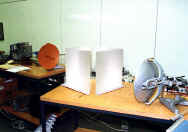 The
complete setup shows the transmitting antenna at the left,
with the receiving antenna at the right. The
complete setup shows the transmitting antenna at the left,
with the receiving antenna at the right.
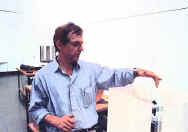 Prof.
Nimtz explaining the tunneling effect on the dielectric prism.
The modulation of the microwave is approx. 1Ghz. and has a
wavelength of 3cm. The gap between the prisms is 5cm, and
tunneling takes place. Prof. Nimtz: "The
waves enter on the left and are being reflected totally on
the first wall. Only when the distance between the two prisms
is not too great the can signal tunnel through the gap. It
looks as if this gap here is the tunnel barrier. When we increase
the gap the signal intensity received at the other end decreases.
This has already been shown by Bose in 1897. But the time
in which the signal traverses the tunnel has not been reliably
measured until now." Prof.
Nimtz explaining the tunneling effect on the dielectric prism.
The modulation of the microwave is approx. 1Ghz. and has a
wavelength of 3cm. The gap between the prisms is 5cm, and
tunneling takes place. Prof. Nimtz: "The
waves enter on the left and are being reflected totally on
the first wall. Only when the distance between the two prisms
is not too great the can signal tunnel through the gap. It
looks as if this gap here is the tunnel barrier. When we increase
the gap the signal intensity received at the other end decreases.
This has already been shown by Bose in 1897. But the time
in which the signal traverses the tunnel has not been reliably
measured until now."
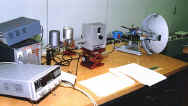
The photon microwave transmitter in detail
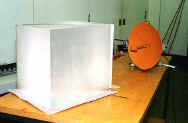
The receiver in close-up
 The
monitor on the left of the setup. shows the tunneled signal
arriving at the receiver on the left. The
monitor on the left of the setup. shows the tunneled signal
arriving at the receiver on the left.
 This
view shows the experiment from the vantage point of the receiving
antenna. Clearly visible is that the receiving antenna is
connected directly with the oscilloscope. This
view shows the experiment from the vantage point of the receiving
antenna. Clearly visible is that the receiving antenna is
connected directly with the oscilloscope.
 The
7854 oscilloscope used in this demonstration. 99.999% of the
emitted signal does not get tunneled. The
7854 oscilloscope used in this demonstration. 99.999% of the
emitted signal does not get tunneled.
 Shown
is an interruption of the microwave beam by Astrid, causing
a flat line on the oscilloscope. In a working experiment setup.
the prism is shielded with insulating material, to eliminate
parasite waves. Shown
is an interruption of the microwave beam by Astrid, causing
a flat line on the oscilloscope. In a working experiment setup.
the prism is shielded with insulating material, to eliminate
parasite waves.
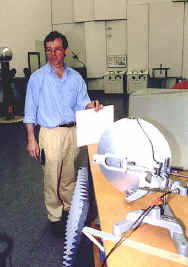 Prof.
Dr. Nimtz demonstrating the effects of mirroring with a metal
plate. The emerging signal is reflected back into the prism
where it changes the characteristics of the tunneled signal. Prof.
Dr. Nimtz demonstrating the effects of mirroring with a metal
plate. The emerging signal is reflected back into the prism
where it changes the characteristics of the tunneled signal.
 This
is the old tunnel type used in experiments as described
in the media previously. Prof. Nimtz: "Until
now we never worked with an experimental setup like the double
prism. Our experiments were always confined to enclosed wave
guides. It is easier to derive exact time measurements from
enclosed wave guides." This
is the old tunnel type used in experiments as described
in the media previously. Prof. Nimtz: "Until
now we never worked with an experimental setup like the double
prism. Our experiments were always confined to enclosed wave
guides. It is easier to derive exact time measurements from
enclosed wave guides."

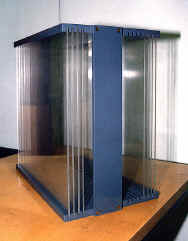 Here
is another tunnel design. Speeds measured on this device exceeded
9x the speed of light, within the frame of reference of this
tunnel. The speed is achieved by the staggered effect of repeated
change from Perspex to air. Here
is another tunnel design. Speeds measured on this device exceeded
9x the speed of light, within the frame of reference of this
tunnel. The speed is achieved by the staggered effect of repeated
change from Perspex to air.
Shown is a
diagram, which appeared in a similar version in the European
Physical Journal B, J.B.7,523. It illustrates the intensity
of the tunneled signal versus time of a normal airborne photon
moving from right to left:
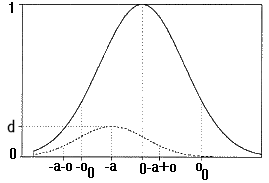
The airborne
signal is shown as a solid line and the tunneled signal is
shown as dots. Both fronts (waves) have traversed the same
distance in the same time, with the light velocity of c.
Here "d" is the maximum of the tunneled pulse, "a"
is the shift of the maximum, "o" is the variance
of the tunneled signal and o0 is the variance of the incoming
pulse. The frequency spectrum can be infinite.
The superluminal signal does not travel back in time!
Instead it arrives before the normal speed
photons. The distance which the signal can theoretically traverse
at superluminal speed is given by the maximum of the untunneled
wave.
The velocity of the tunneled signal is measured against
the velocity of a signal not being tunneled.
In the case of unlimited frequency bands the high-energy
components do not tunnel in the wave-mechanical barrier. According
to Nimtz these high energy components form a front which travels
with the speed of light and cannot be
overtaken by the low frequency superluminal tunneling modes.
The superluminal signals are shifted to earlier pulse arrival
time. They overtake the front of the signal traveling at light
speed and are thus not violating Einstein causality.
We cannot observe any
signal moving faster than light! Nimtz explains
it thus: "The analogy between the Schroedinger equation
and the Helmholtz equation holds true. It is not possible
to measure an evanescent mode. Obviously evanescent modes
are not directly measurable in analogy to a particle in a
tunnel."
What are evanescent modes? Nimtz describes these as low-frequency
superluminal tunneling modes, which have a lower energy-content
than the potential barrier.
Due to the large number of questions raised by this
experiment I have decided to enable our readers to review
the "Annalen der Physik, Leipzig, 7, (1998) 7-8, pages
618-624." I hope this article by Prof. Dr. Nimtz, which
is intended to be shown here for review only, will lead to
a better understanding. I am publishing the paper without
alterations, so as to avoid misinterpretations and further
confusion.
Click
here for
"SUPERLUMINAL SIGNAL VELOCITY"
by G. Nimtz.
Acknowledgments:
I would like to thank Prof. Nimtz for taking the time
to explain his experiments to me in detail
Thanks to Darrel Emerson, for the use of the Bose diagram.
|